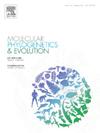Mixed, not stirred: Genomic data confirm the first case of interspecific hybridization in planarian triclads (Platyhelminthes: Tricladida) and raise questions about a possibly novel form of hybrid speciation
IF 3.6
1区 生物学
Q2 BIOCHEMISTRY & MOLECULAR BIOLOGY
引用次数: 0
Abstract
Speciation is a complex process where many evolutionary forces interplay. The Mediterranean is acknowledged as one of the most relevant biodiverse areas in the Palearctic region and researchers have long studied the species inhabiting it to pursue the goals of evolutionary biology. Here, we study a complex of freshwater flatworm species of the genus Dugesia from Corsica and Sardinia using restriction site-associated DNA sequencing (specifically, 3RAD) data to unravel their evolutionary history and tackle the processes driving it. We assess the phylogenetic relationships and population structure within the group and evaluate new species boundaries using multispecies coalescent approaches. Furthermore, we offer insights into the environmental niche model of the group and use said model to guide our sampling efforts and collect and present molecular evidence for the first time of Dugesia leporii specimens, endemic from Sardinia last spotted in 1999. Our results indicate that paleoclimatic conditions rather than microplate tectonic dynamics were likely an important driver of diversification for the Corso-Sardinian group. Furthermore, our results warrant the taxonomic re-evaluation of the group as eight primary species candidates are established based on molecular data. Our study also reveals the first case of interspecific natural hybridization reported in Dugesiidae and, to our knowledge, in Tricladida. Finally, we discuss how this hybridization might constitute a new form of hybrid speciation.

混合,而不是搅拌:基因组数据证实了涡虫三头虫(Platyhelminthes: Tricladida)种间杂交的第一例,并提出了一种可能的新形式的杂交物种形成的问题。
物种形成是一个复杂的过程,许多进化力量相互作用。地中海被认为是古北极地区最具生物多样性的地区之一,研究人员长期以来一直在研究居住在地中海的物种,以追求进化生物学的目标。在这里,我们研究了来自科西嘉岛和撒丁岛的淡水扁形虫属的Dugesia物种,使用限制性内切位点相关DNA测序(特别是3RAD)数据来揭示它们的进化史并解决驱动它的过程。我们评估了系统发育关系和种群结构,并利用多物种聚结方法评估了新的物种边界。此外,我们提供了该群体的环境生态位模型,并使用该模型指导我们的采样工作,并首次收集并提供了撒丁岛特有的Dugesia leporii标本的分子证据,最后发现于1999年。我们的研究结果表明,古气候条件而不是微板块构造动力学可能是科索-撒丁岛群多样化的重要驱动力。此外,我们的研究结果保证了该类群的分类重新评估,因为基于分子数据建立了8个主要候选物种。我们的研究还揭示了首次报道的Dugesiidae种间自然杂交,据我们所知,在Tricladida。最后,我们讨论了这种杂交如何构成一种新的杂交物种形成形式。
本文章由计算机程序翻译,如有差异,请以英文原文为准。
求助全文
约1分钟内获得全文
求助全文
来源期刊
CiteScore
7.50
自引率
7.30%
发文量
249
审稿时长
7.5 months
期刊介绍:
Molecular Phylogenetics and Evolution is dedicated to bringing Darwin''s dream within grasp - to "have fairly true genealogical trees of each great kingdom of Nature." The journal provides a forum for molecular studies that advance our understanding of phylogeny and evolution, further the development of phylogenetically more accurate taxonomic classifications, and ultimately bring a unified classification for all the ramifying lines of life. Phylogeographic studies will be considered for publication if they offer EXCEPTIONAL theoretical or empirical advances.

 求助内容:
求助内容: 应助结果提醒方式:
应助结果提醒方式:


